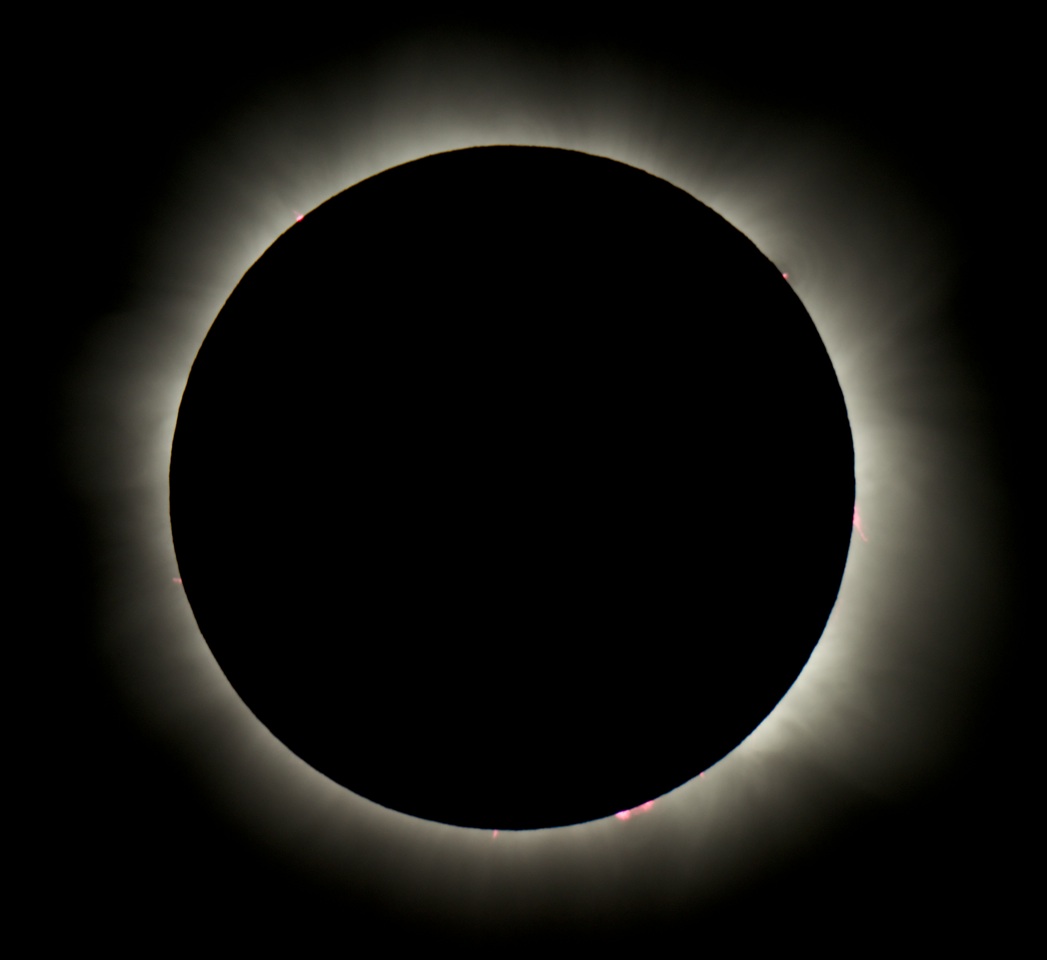
Depending on where you live, either this Tuesday or Wednesday (March 8 or 9), there will be a total solar eclipse. But to seeit, you'll have to journey to Indonesia, sail on a ship or fly in an aircraft over the North Pacific Ocean.
Remember: Never look directly at the sun, even with sunglasses. Space.com discusses the safest ways to observe the sun in this infographic.
A calendar conundrum
If you were to go to Indonesia for the eclipse, you would be to the west of the international date line, where the calendar date will be Wednesday, March 9. The narrow path of totality — where the moon's dark cone of shadow, called the umbra, will track across the Earth — begins here, and then stretches eastward across the Pacific Ocean. Roughly three-quarters of the way east along the eclipse track, it crosses the date line, and correspondingly, the date will transition from Wednesday, March 9, to Tuesday, March 8. So, here, we have the unusual circumstance of an eclipse beginning the day after it ends! [March 2016 Solar Eclipse - Mostly Out to Sea]
You can watch next week's total solar eclipse live in a webcast hosted by the Slooh Community Observatory. The Slooh broadcast will begin March 8 at 6 p.m. EST (2300 GMT) and will stretch until 9 p.m. EST (2600 GMT). You can also watch the webcast on Space.com, courtesy of Slooh.
The story of the shadow

The moon's dark umbral shadow will first strike the Earth's surface over the eastern Indian Ocean about 900 miles (1,400 kilometers) west of Sumatra at 0017 GMT on March 9. Just 2 minutes later, the shadow will sweep across central Sumatra and then envelop the much smaller islands of Bangka and Belitung. In the Makassar Strait, a cruise ship with more than a thousand rabid eclipse chasers will be waiting for the arrival of the lunar shadow. Totality here will last 2 minutes and 45 seconds. Should unfavorable weather conditions prevail, the ship will utilize its mobility to seek out a location where good breaks in any cloud cover may afford a view of this amazing spectacle.
Then, it's on to southern Borneo and northern Sulawesi.
After passing across the Molucca Sea, the umbra will pass over Halmahera, before heading out over the open waters of the South Pacific. Traveling to the northeast, the shadow will pass 335 miles (540 km) south of Guam, where local residents will see 84 percent of the sun obscured.
Breaking space news, the latest updates on rocket launches, skywatching events and more!
Viewers 350 miles (560 km) east of Manila, Philippines, will see the maximum duration of totality — 4 minutes and 9.5 seconds. The umbra does not make contact with any other land masses, although it will narrowly miss Wake Island — one of the most isolated islands in the world — providing those few who man the Wake Island Airfield a chance to see more than 99 percent of the sun covered at maximum eclipse. As Maxwell Smart might have said, "Missed it by that much!"
The shadow will leave the surface of the Earth at 0336 GMT, about 900 miles northeast of the Hawaiian Islands.
In all, the moon's umbra will take 3 hours and 21 minutes to trace a path, like a black crayon, that will stretch for 8,800 miles (14,200 km) and will average 78 miles (125 km) in width.
Unexpected bonus for airline passengers
If you draw a line from Anchorage, Alaska, to Honolulu, the totality path of the eclipse will cross this line at almost a right angle; it might just be possible for an aircraft either traveling north from Honolulu to Anchorage, or south from Anchorage to Honolulu, to possibly intercept the moon's dark umbral shadow.
And that is precisely what Alaska Airlines intends to do!
The passengers who board Alaska Airlines flight 870 in Anchorage are probably wondering why it differed from the regularly scheduled departure time (compared to other days) by 25 minutes, but that is necessary in order to try and intercept the shadow on route to Hawaii. The aircraft, a 737-800, plans to rendezvous with the moon’s dark umbra at 5:35 p.m. Hawaii-Time on Tuesday, at a point 695 miles (1,120 km) north of Honolulu.
Certainly, this rare opportunity to catch a glimpse of nature's greatest sky show will trump any in-flight movie! [Last Year's Total Solar Eclipse in Amazing Photos]
In the partial-eclipse zone
Hawaii and most of Alaska will see a partial eclipse near sunset on the afternoon of March 8. Alaskans will see the passing new moon take only a small scallop out of the sun, but from Honolulu, 70 percent of the sun's diameter will be eclipsed at 5:36 p.m. Hawaii Time (0330 GMT on March 9). If you live in the visibility zone of this eclipse, the most important thing to keep in mind is to never look at even a portion of the sun directly without proper viewing glasses. Such special eyewear has filters specially designed for viewing the sun, and can be found at some science stores, planetariums and online. An alternative is to purchase a piece of number 14 welder's glass from a welding supply store. Sunglasses are not acceptable for viewing a solar eclipse, and your eyes can be permanently damaged by looking even for a fraction of a second at any eclipse. Telescopes and binoculars must be outfitted with special filters before they can be safely used. Only during the total phase can the sun be viewed directly without any special filters.
For more details on this eclipse, check out Fred Espenak's EclipseWise.com.
Next on the eclipse docket
On Sept. 1, an annular ("ring of fire") eclipse will sweep across southern Africa and Madagascar. Then, next year, on Feb. 26, yet another annular eclipse will cross parts of southern Chile and Argentina and will then sweep across the Atlantic Ocean, moving over land again in Africa and touching parts of Angola, Zambia and the Democratic Republic of the Congo, before leaving Earth just to the west of the mining city of Lubumbashi in a brilliant, ringlike sunset.
And then, on Aug. 21, 2017, a total solar eclipse will come to the United States. It will be the first time since 1979 that the umbra will touch down over the 48 contiguous states, taking 90 minutes to streak from the Pacific coast of Oregon to the Atlantic coast of South Carolina. It will be the first coast-to-coast total solar eclipse since 1918. Without a doubt, the "Great American Eclipse of 2017" will be one of the big events of that year. Space.com will provide extensive coverage on all aspects of that event as we get nearer to it, so stay tuned!
Editor's note: If you safely capture an amazing photo of the March 8 total solar eclipse and would like to share it with us and our news partners for a story or gallery, send images and comments in to managing editor Tariq Malik at spacephotos@space.com.
Joe Rao serves as an instructor and guest lecturer at New York's Hayden Planetarium. He writes about astronomy for Natural History magazine, the Farmer's Almanac and other publications, and he is also an on-camera meteorologist for News 12 Westchester, New York. Follow us @Spacedotcom, Facebook or Google+. Originally published on Space.com.
Join our Space Forums to keep talking space on the latest missions, night sky and more! And if you have a news tip, correction or comment, let us know at: community@space.com.

Joe Rao is Space.com's skywatching columnist, as well as a veteran meteorologist and eclipse chaser who also serves as an instructor and guest lecturer at New York's Hayden Planetarium. He writes about astronomy for Natural History magazine, Sky & Telescope and other publications. Joe is an 8-time Emmy-nominated meteorologist who served the Putnam Valley region of New York for over 21 years. You can find him on Twitter and YouTube tracking lunar and solar eclipses, meteor showers and more. To find out Joe's latest project, visit him on Twitter.
